Tie-Dye Mango Strawberry Fruit Leathers
This post may contain affiliate links.
A tropical kaleidoscope of flavor and color, these tie-dyed fruit leathers are our healthy-ish riff on the classic 90’s snack food Fruit-by-the-Foot. They’re a perfect grab-and-go snack for backpacking, day hikes, and long road trips.
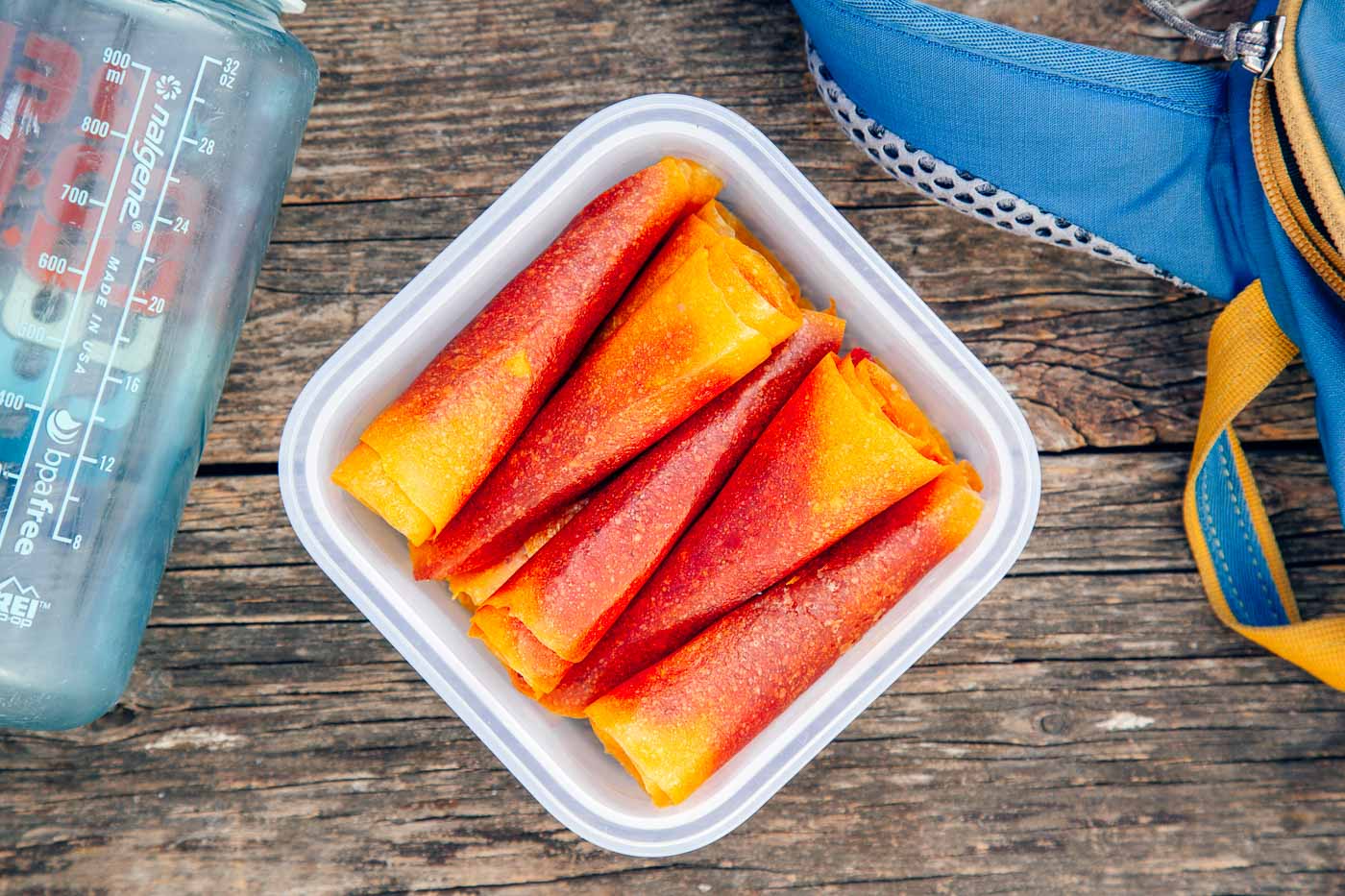 These mango strawberry fruit leathers are like a tropical vacation for your taste buds. Light, bright, and delightfully fruity, they can instantly zip you into a shorts-and-sandals state of mind. But a word of caution: you’ll gobble these up quicker than you expect, so make a lot!
These mango strawberry fruit leathers are like a tropical vacation for your taste buds. Light, bright, and delightfully fruity, they can instantly zip you into a shorts-and-sandals state of mind. But a word of caution: you’ll gobble these up quicker than you expect, so make a lot!
While it’s theoretically possible to make this recipe in an oven, fruit leathers are best made using an actual dehydrator. The ideal temperature is 135 F and most home ovens can’t go that low. Even with the oven door cracked ajar, the heating will be uneven at best. So if you don’t have one already, we’d suggest picking up an inexpensive dehydrator before making this particular recipe.
In terms of flavor, fresh fruit is ideal. But in terms of convenience, flash-frozen fruit from the freezer section is not a bad option either. Just make sure the fruit is completely thawed before starting.
Why We Love Tie-Dyed Fruit Leathers
↠ A fun, artsy twist on classic fruit leathers
↠ Little distinct pockets of flavor with each bite
↠ No artificial flavors or colors!
So if you’re looking to put a twist on your fruit leather game, give these psychedelic tie-dye mango strawberry fruit leathers a try!
How to make tie-dyed fruit leathers & step by step video
Learn how to make these mango strawberry fruit leathers by watching this 60 second video!
To get the tie-dye effect, prepare the fruit in two different batches. In a food processor, place your room temperature mangos and juice of half a lemon and blend until smooth. Pour the mango puree into a bowl, clean the food processor (to prevent color contamination) and repeat the process for the strawberries.
Using a paper towel, wipe a thin layer of coconut oil (or other neutral-flavored oil) onto your dehydrator sheets. This step is critical as it will prevent the fruit leather from sticking to the tray and potentially tearing when attempting to remove it.
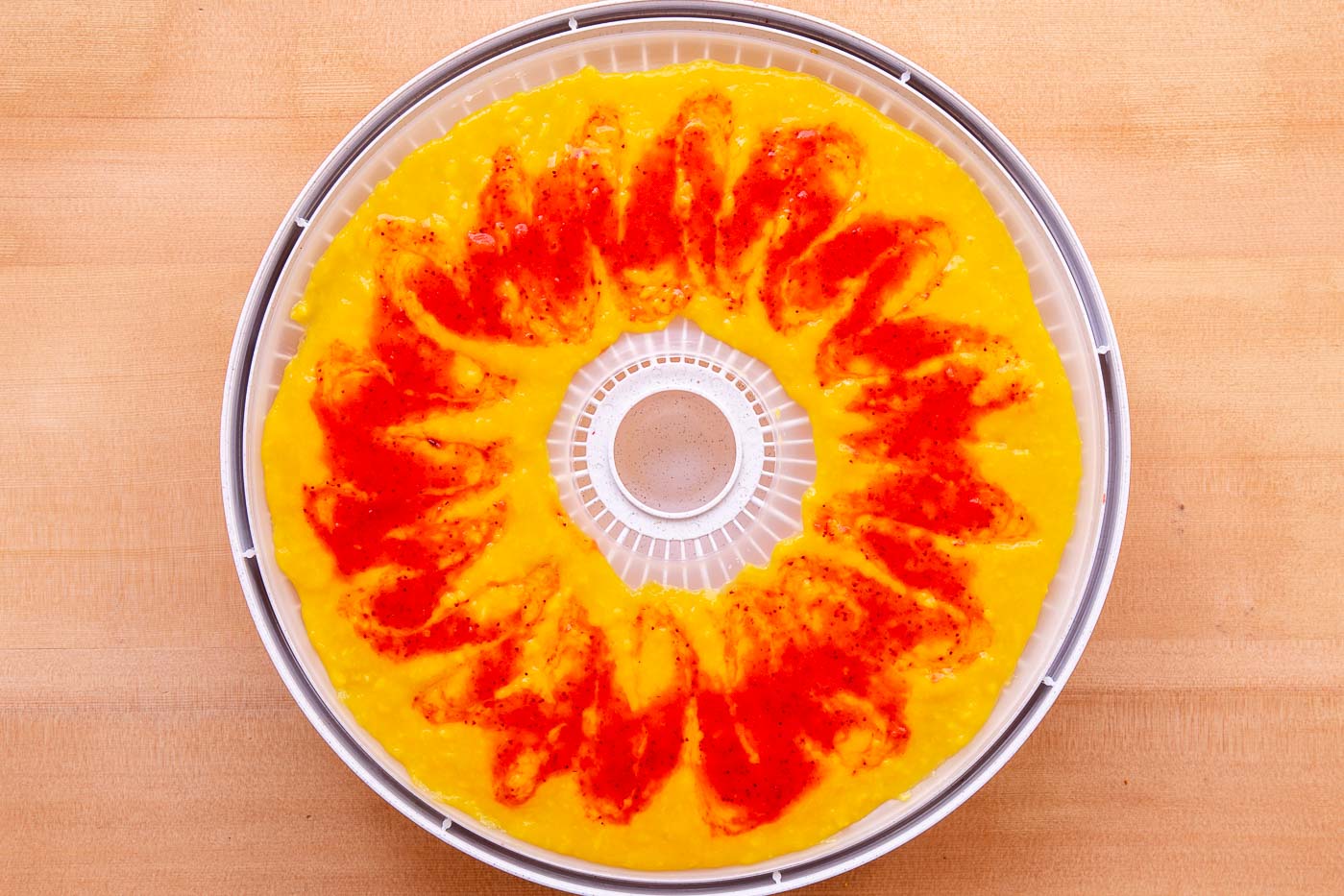
Begin with the mango puree. Spread out an even layer onto your dehydrator’s fruit roll sheets using an offset spatula. Ideally, you’re looking for a layer ⅛ inch thick. Once the mango layer is down, pour a ring of strawberry puree in the middle. Then go back with a fork to create a swirly pattern with the strawberry (see photo or video above). Give the tray a little jiggle to help the puree settle into a more even layer. Repeat the process on subsequent trays.
Place the trays inside the dehydrator and set to 135 F. Unlike other dehydrator recipes, it is possible to over dehydrate fruit leathers. Left in too long they’ll become brittle and will crack easily. So you’ll need to check periodically throughout the process. Aim to start checking around 6 hours. You will know when they’re done when they’re dry but just ever so slightly tacky.
Remove, cut into sections, roll, and then store in a sealable container.
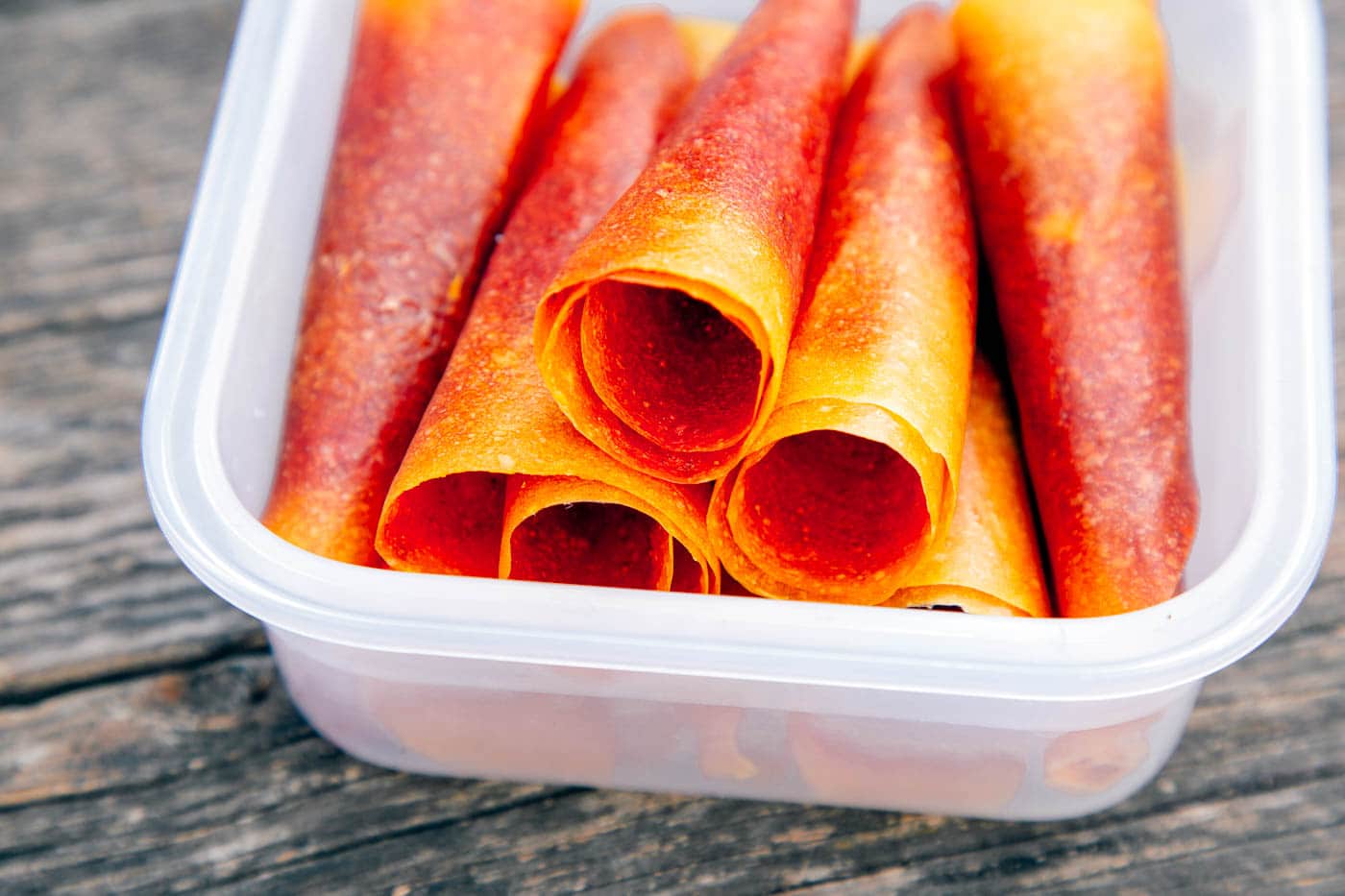
How to store fruit leathers
Truth be told, we usually eat these things within the first hour. But when testing this recipe, we deprived ourselves for the sake of science.
We rolled ours up and placed them in a reusable, sealable container (as shown at the end of the video.) When it comes to fruit leather, air is the enemy. It will continue to dry them out and make them hard and brittle. So keep them sealed up in a container to maintain their flexible texture.
We kept ours out on the counter for a week and they were just as good as when we first made them. For any time longer than a week, you’ll want to store them in the refrigerator. They’ll last a few weeks in there.
The bottom line: fruit leathers are great for short trips within a week, but probably shouldn’t be used in a long term food caching.
Equipment needed
↠ Dehydrator: There are a lot of options out there, but we’re currently using the Nesco Snackmaster. It’s a budget-friendly dehydrator that’s good if you’re just getting started.
↠ Fruit Leather Trays: Your dehydrator might come with a few of these, but if not, be sure to pick some up. Alternatively, you can use parchment paper.
↠ Electrical Outlet Timer: Don’t have a fancy dehydrator with a timer and auto-off function? Us too! But for less than $10, you can pick up an electrical outlet timer and set a start and stop time.
↠ Offset Spatula: To achieve an even, uniform layer fruit puree, nothing works quite as well as an offset spatula.
Other hiking snack recipes you’ll enjoy
↠ Chili Spiced Fruit Leathers
↠ Peanut Butter & Jelly Bars
↠ Tropical Fruit Leathers
↠ Teriyaki Beef Jerky
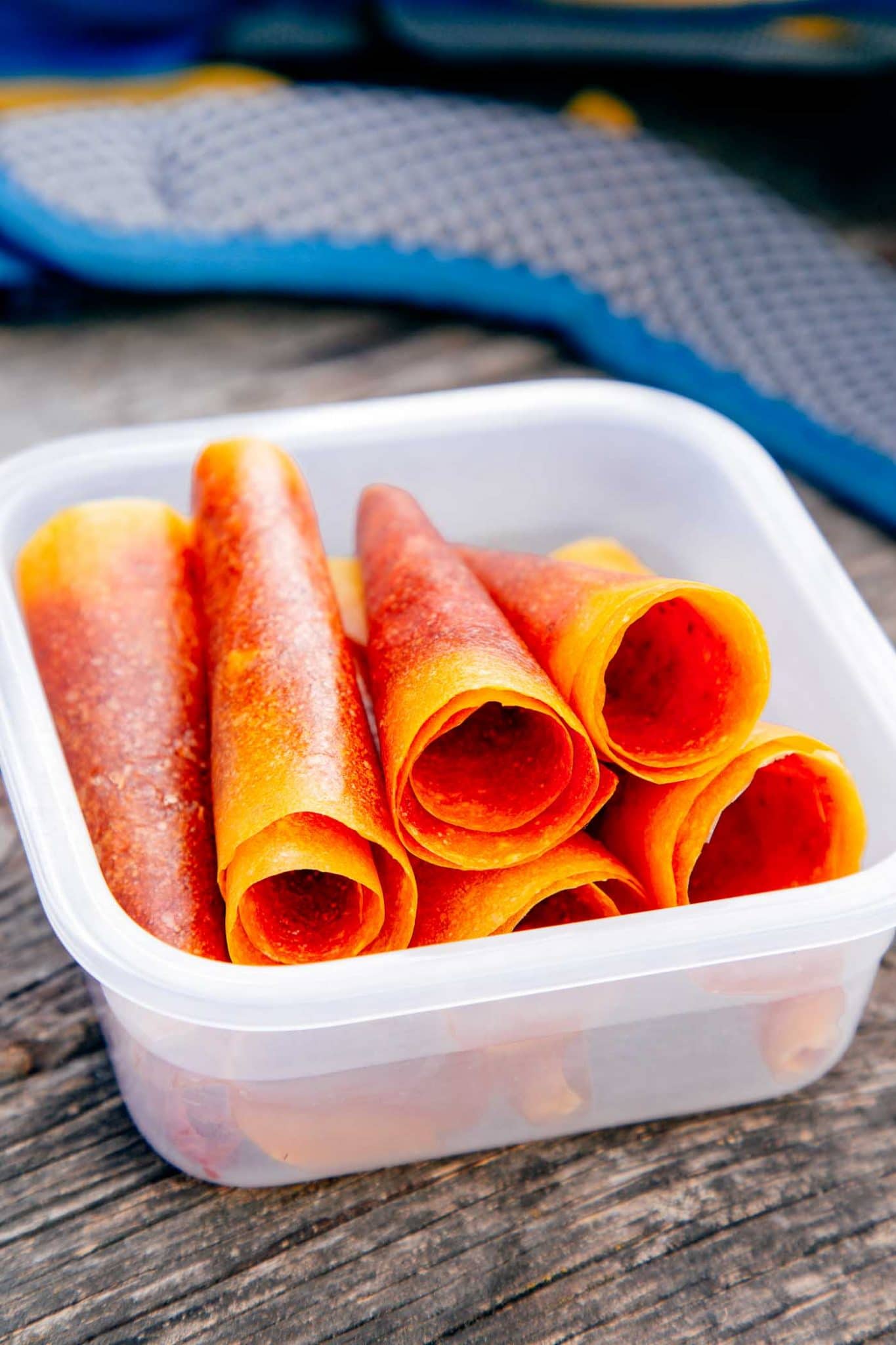
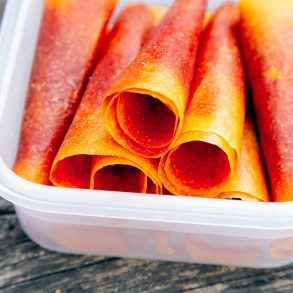
Tie-Dye Mango Strawberry Fruit Leathers
Equipment
- Blender/Food Processor
Ingredients
- 1 pound frozen mangoes, thawed
- ½ pound frozen strawberries, thawed
- ½ lemon, juiced
- Coconut oil
- 1 tablespoon sugar, optional
Instructions
- Thaw the frozen fruit.
- Place the mangoes (and any accumulated juices), lemon juice, and sugar (optional) into a food processor and blend until smooth. Transfer into a bowl and set aside. Wipeout or rinse the food processor bowl.
- Place the strawberries (and any accumulated juices) into a food processor and blend until smooth. Transfer into a bowl.
- Lightly oil a dehydrator fruit leather tray and pour enough mango puree to create a ⅛” thick layer (exact amount will depend on the size of your dehydrator trays). Using an offset spatula is helpful in evening out the mixture.
- Pour strawberry puree on top of the mango puree. If your trays are circle, pouring it in a circle in the middle of the tray works best. If your trays are rectangular or square, pour in straight horizontal lines. Using a fork, swirl the strawberry into the mango to create designs.
- Repeat with remaining trays/puree.
- Dehydrate at 135F for 6-10 hours, checking periodically after 4 hours to monitor progress. The leathers are done when the fruit is no longer soft or sticky, but is not yet brittle.
- Remove leathers from the trays, cut, and roll for storage. Store in an airtight container.

